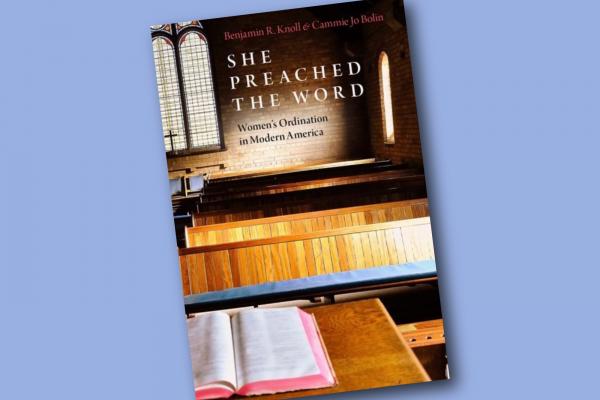WHEN I WAS IN COLLEGE, I asked one of my faith leaders at the time why no women were in positions of authority in that ministry. He said that the male leaders’ wives were always available to serve as mentors. Besides, he added, if they hired a woman, she would just get married and quit to raise a family.
I left, I fumed, and then I read Sarah Bessey’s Jesus Feminist, which told me that not only could women serve as pastors and leaders in the church, but that Jesus wanted them to.
If that were so, I wondered, why had I encountered so few female faith leaders?
Benjamin R. Knoll and Cammie Jo Bolin have provided an answer. In She Preached the Word: Women’s Ordination in Modern America, Knoll and Bolin examine why women still make up just 15 percent of congregational clergy.
Knoll, a professor of politics at Centre College, and Bolin, a political science graduate student at Georgetown University, observed that many of the debates surrounding female ordination are drawn from generalizations formed from personal experiences and anecdotal examples. What was missing, Knoll and Bolin concluded, was “systematic, comprehensive, and generalizable empirical evidence.”
Knoll and Bolin began their research with the following questions: Who supports women’s ordination in their congregations and why? What effect do female pastors, priests, rabbis, and other leaders have on their congregants?
Knoll and Bolin collected data through a nationally representative telephone/internet public opinion survey and conducted face-to-face interviews with people in the pews and in the pulpits. They focused on how women’s presence in the pulpit—or lack thereof—and the views congregants hold about female ordination impact women in all positions of leadership in American society.
Lack of female leadership is an interesting phenomenon, one that leaves more questions than answers, especially given the impact female religious leaders have on the life trajectories of the young women in their congregations. Knoll and Bolin’s data reveals that women who grow up with a female religious leader show “higher levels of both personal and economic empowerment” as adults—to the extent that the “gender gap on these two outcomes disappears entirely.” Moreover, “influential religious leaders in a girl’s youth are associated with increased levels of educational attainment, self-efficacy, self-esteem, and even more gracious views of God as adults.” The presence of female clergy had no impact on men’s empowerment, which remained high with either male or female clergy.
While congregants cited scripture and belief orthodoxy as reasons why women should not be clergy, Knoll and Bolin found that congregational context also has some impact. “Even highly religious and theologically traditionalist folks will get behind female ordination when they attend congregations whose policies allow for it,” Knoll and Bolin write. In other words, congregants tend to follow their congregation’s lead.
Church attendance is affected by those decisions, as more people of faith are paying attention to who’s in the pulpit and serving in church leadership. Knoll and Bolin observed that “levels of attendances and other religious behaviors are slightly higher in congregations that ordain women.” U.S. congregations should take note, as overall rates of attendance at religious services have plummeted over the years, especially among millennials and political progressives. In fact, 43 percent of millennials said they would be more likely to attend church if their congregation permitted women to serve as the leader.
In their conclusion, Knoll and Bolin provide suggestions for congregations in light of their findings. They emphasize that switching from male-dominant to female-dominant leadership is not the answer. Rather, the best results come from equalizing gender leadership—“inviting women to serve as a congregation’s principal leader as often as men and by making sure that the lay ministry positions are shared evenly between men and women.”
For many young women, the glass ceiling feels increasingly impossible to crack. She Preached the Word reveals that one of the best ways to empower women today is to give them the pulpit. As Knoll and Bolin conclude, “gender equality in religious congregational leadership is a necessary precondition for gender equality in American society at large.”

Got something to say about what you're reading? We value your feedback!







